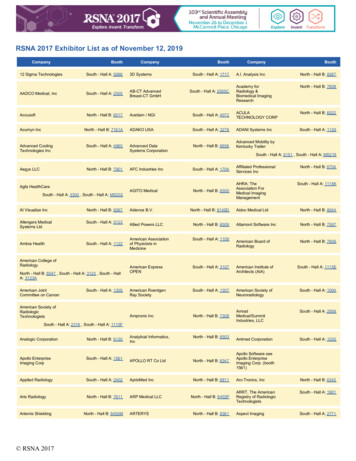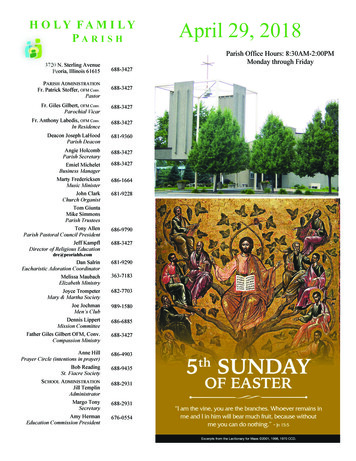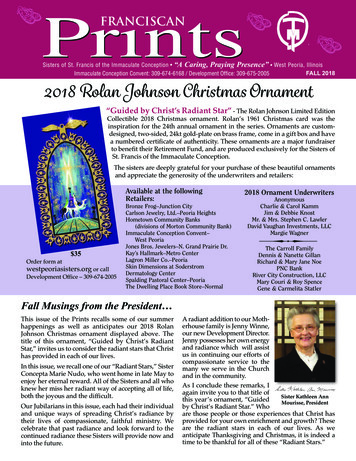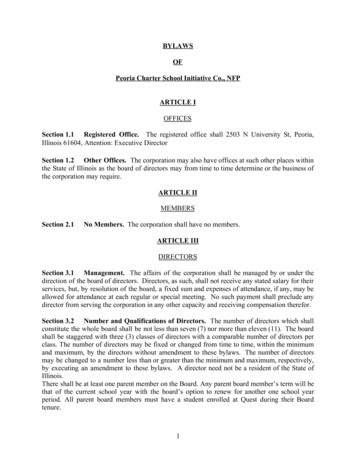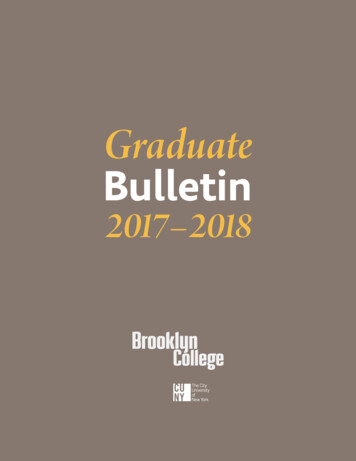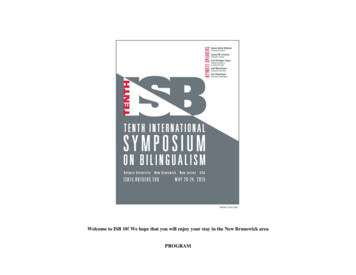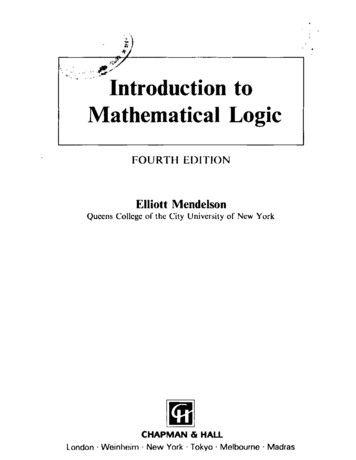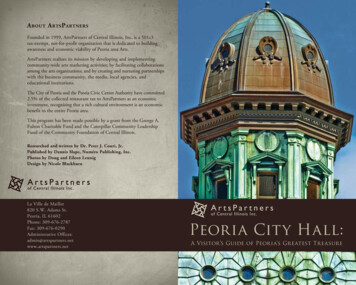
Transcription
A bout A rts P artnersFounded in 1999, ArtsPartners of Central Illinois, Inc. is a 501c3tax-exempt, not-for-profit organization that is dedicated to buildingawareness and economic viability of Peoria area Arts.ArtsPartners realizes its mission by developing and implementingcommunity-wide arts marketing activities; by facilitating collaborationsamong the arts organizations; and by creating and nurturing partnershipswith the business community, the media, local agencies, andeducational institutions.The City of Peoria and the Peoria Civic Center Authority have committed2.5% of the collected restaurant tax to ArtsPartners as an economicinvestment, recognizing that a rich cultural environment is an economicbenefit to the entire Peoria area.This program has been made possible by a grant from the George A.Fulton Charitable Fund and the Caterpillar Community LeadershipFund of the Community Foundation of Central Illinois.Researched and written by Dr. Peter J. Couri, Jr.Published by Dennis Slape, Numéro Publishing, Inc.Photos by Doug and Eileen LeunigDesign by Nicole BlackburnLa Ville de Maillet820 S.W. Adams St.Peoria, IL 61602Phone: 309-676-2787Fax: 309-676-0290Administrative Peoria City Hall:A Visitor’s Guide of Peoria’s Greatest Treasure
“The new building stands today a model of what Peoria contractors,Peoria architects, and Peoria artisans can do. It is said by thosewho have visited similar buildings in various parts of the UnitedStates, that while there are larger and more expensive buildings inthe country, there are none more complete or substantial.”Peoria Herald—January 6, 1899F orwa r dn 1978, internationally renownedarchitect Philip Johnson looked outover downtown Peoria from thetop floor of the Commercial National BankBuilding. He was in Peoria to design thenew Peoria Civic Center. Johnson told thecity leaders that he envisioned a necklace ofsparkling jewels, wrapped around the neckof the Grande Dame, Peoria City Hall. Hewanted to enhance the central importanceand rich architectural heritage of Peoria’smost significant building.The Peoria City Hall Visitor Guide will elevateyour awareness of this “working museum”as you learn of its construction, the artworkhoused throughout the building, and howthe Native American, French, and Americancultures shaped the Peoria we have today.D r . P e t e r J. C ou r iJ u n e 20101
Cont e nts2 Peoria City Hall Facts.52 Historical OverviewPeoria in the 1890s.8Planning for a New Peoria City Hall, 1894.11The Work Begins.11Laying the Cornerstone.12Dedication Ceremonies, 1899.15Mayor John Warner’s Dedication Speech.162 Peoria City Hall ArtworkFirst FloorLithographs of 1890s Peoria.21Victorian Ceiling Mural.25Decorative Ornate Ironwork.25“Love Knows No Caste” Sculpture.26Second FloorSecond Floor Mayor’s Office Fireplace, 1880s.29Fourth FloorPeoria City Council Chamber.30Peoria City Council Chamber Mural.33“Henri de Tonti, Founder of Peoria, at Pimiteoui 1691-93” Painting.34“Peoria, August 29, 1831” Mural.36Downtown Peoria Aerial View Photographic Mural.392 Outside FeaturesThe Peoria City Hall Bell.40The Story of the Banded Orbs.432 National Register of Historic Places for PeoriaCounty & Their Dates of Induction.442 100th Anniversary Time Capsule & Celebration.472 Acknowledgments.483
Peoria City Hall FactsPlans for construction: June 4, 1894Construction: 1895-1898Location: 419 Fulton Street, on the site of the MarketHouse, Peoria’s covered outdoor produce marketplaceCornerstone Dedication: November 2, 1897Opening Dedication: January 5, 1899Cost: Building— 234,592 Furnishings— 36,918Contractor: William Allen, mayor of Peoria. Paymentfor contract— 123,275Architects: Reeves & Baillie of Peoria. Payment for plansand superintendent— 8,845Architectural Style: Flemish RenaissanceExterior Features: Lake Superior red sandstone (quarriedby inmates), copper cupola bell tower, ornamentedstepped gables, banded orbs above the arched entrancesInterior Features: Open atrium rotunda topped with“Tiffany-style” stained glass skylight, hangingstaircases with decorative cast iron “egg & dart”molding, custom-designed PCH doorknobs,barrel-vaulted ceiling with coffered squares, centralatrium leaded glass windows, red oak trim, Italianmarble wainscotingHistoric Art: City council chamber mural of the 3 Muses—Peaco, 1912“Henri de Tonti, Founder of Peoria, at Pimiteoui,1691-93”—Lonnie Stewart, 1991“Peoria, August 29, 1831”—J.M. Roberts, 1831“Love Knows No Caste”—Fritz Triebel, 1889Ceiling mural—Trapp & Hocking, 1898National Register of Historic Places: February 6, 19735
Historical OverviewPeoria in the 1890sPlanning for a New Peoria City Hall, 1894The Work BeginsLaying the CornerstoneDedication Ceremonies, 1899Mayor John Warner’s Dedication Speech7
Peoria in the 1890sPeoria had grown to be Illinois’ second-largest city with apopulation on the verge of exceeding 100,000. Peoria wasthe 16th largest manufacturing center in America. Peoria had554 manufacturing establishments representing 90 differentindustries. Some major ones were distillery products, bicycles,agricultural implements, threshers, hardware, cooperage,flour, building materials and bricks. Peoria had the lowestunemployment in the nation. With 18 distilleries using35,000 bushels of grain to make 167,000 gallons of spirits perday, Peoria produced more distilled spirits and liquors than anyother city in the world. Peoria was called the “hub of theinternal revenue world” and contributed more internal revenuetax on alcohol to the federal government than any other cityin the United States. Her contributions exceeded those ofNew York, Philadelphia and Boston by 50 percent. Peoriahad 13 railroads with two under construction. There wereover 100 daily passenger trains. Peoria had 12 banks withcombined capital topped by only a few cities in the nation. The entire city had a complete sewage and drainage system.Almost all streets were broadened and paved. The waterworks system was rated the best in the nation. Peoria had 15schools considered models for the nation and looked with prideat the newly opened Bradley Polytechnic Institute. Peoriacreated Illinois’ first park district in 1894. By 1899, there were286 acres of developed parks, including Glen Oak Park (92acres), Laura Bradley Park (140 acres), South Park (10 acres)and Madison Park (88 acres). Peoria’s public library had over60,000 volumes and was considered more complete than citiesmany times Peoria’s size.8View of South Adams StreetFree Bridge at Foot of Lake9
Planning for a NewPeoria City Hall, 1894With so much wealth and prosperity, Peorians roundly agreed that acity structure be built that would fit the growing needs of the city.On June 4, 1894, Mayor Philo Miles announced plans for a newPeoria City Hall. The building was not to exceed 100,000. Thefaçade was to be designed and finished on all four sides. There wereto be no towers or domes. The windows were required to be large andup to the ceiling. The four-story structure was to house the mayor’soffice and departments of the legislature, finance, public works, law,health, police, fire, boiler inspector, building and harbormaster.The city’s covered outdoor produce market on the corner of Madisonand Fulton was chosen as the site. The existing small, two-story cityhall (built in 1859) was next door on Fulton. The city paid 43 tohave the Market House torn down. For many years, people lamentedthe loss of what had become Peoria’s meeting and gossip center. (Thehorseradish sauce that was sold at the market was also sorely missed.)The Work BeginsWilliam Allen was mayor of Peoria in 1895, but that did not stopcity officials from choosing him to be the contractor for the new CityHall. He had never built a building before. Erection of the buildingwould take 15 months.11
City officials deposited copies of all the city newspapers, a copy of the city ordinancesand photographs of all city officials into the cornerstone box. Major Henry Wells hadvisited Egyptian pyramids and copied one of their ideas by submitting an electrotypeof the conjunction of the planets on November 2, 1897, a conjunction that will notoccur again for 30,000 years. Former mayors donated their farewell addresses. Peoplethrew in their business cards and family photographs, railroad tickets, a plumber’sbill, greetings from the mayor of Kraewinkel, and a Horsten rivet. Even a handfulof buckeyes found their way into the cornerstone box.The Peoria Evening Star satirized, “The powers to be might have added a bottleof aroma from the West Bluff sewer system, a can of oysters which caused so muchdisturbance at the Columbus junket, and a chart of air currents as recorded bythe city engineer’s anemometer when Alderman Carroll is making a speech.”On Tuesday, November 2, a large crowd gathered as Spenser’s Band played patrioticsongs. Mayor Warner apologized for the construction mess. Alderman WilliamCarroll spoke of how proud he was that City Hall was being designed by Peoriansand that mechanical and manual labor would be done completely by Peorians.Bishop John Spalding remarked, “We have a population of intelligent, moral, sober,enlightened men and women. I do not believe we can find a better populationanywhere. Let us now be an example to all other cities of the kind of governmentthat should prevail in cities.” He also praised Mrs. Lydia Bradley, who just a fewweeks before, had dedicated a school of the highest value for the good of the people.Laying the CornerstoneIn October 1897, the autumn leaves had fallen, and the brisk, cold weather wasstarting to settle in. Peoria Mayor John Warner was worried about winter delayingthe city’s biggest project in its history, the construction of a new City Hall, sohe quickly announced that on November 2, 1897, the cornerstone of the buildingwould be laid without the grand, majestic ceremonies so fitting such a historicevent. The formal dedication would come when the new City Hall was finished.12Peorians were invited to come down and place mementos they wanted to leave forthe future generations. Hundreds of people waded through mountains of sand anddodged the tangle of metal construction materials and red sandstone that stretchedacross Madison and Fulton streets to reach the 12” x 12” x 6” copper box.The mayor of North Peoria, Oliver J. Bailey, noted that the new City Hall should putto rest Peoria’s reputation as “a slow-going, fogy old town who believe that tallowcandle light, mule cars, the river bank for parks, and mud roads are good enough.”Judge Nicolas E. Worthington hoped people would gather around the cornerstonein 50 years with a Peoria population that had reached 200,000.While the band played, Mayor Warner placed the copper memento box into thecornerstone and slopped some mortar on it. Samuel Woolner was the next speakerand joked, “I hope the laboring men will not object, because Mayor Warner, whojust laid the cornerstone, is not a union man.”M.C. Quinn spoke last and gave a historic account of Peoria’s 53 years of citygovernment, with amusing tales of early mayors and alderman. He noted thatin 1845 we paid the mayor only 1 for each council meeting attended and the cityattorney 100 a year.The ceremony ended and construction began in earnest. For the next 15 months,Peorians labored with pride to build what was called the finest city hall built in its time.13
Dedication Ceremonies, 1899Colonel John Warner has the distinction of being not only Peoria’s most celebrated CivilWar hero but also the city’s second-longest-serving mayor. Elected eight times, he hadincessantly advocated and agitated for the idea of a new Peoria City Hall to meet the city’sgrowing needs. Thus it was with great honor that John Warner became mayor one lasttime and the reward of dedicating the new building would be his.The dedication celebration started on Monday night, January 4, 1899, with anelaborate banquet at the Hotel Prochazka, just down the street from City Hall. ThePeoria Journal wrote, “There were no fewer than 12 courses, and everything was of thefinest description. The tables looked very handsome in profuse decorations of roses,carnations, and verdure, interspersed with candelabra; and the dining hall was adornedwith wreaths and festoons of evergreen. Young ladies dressed in white served the repast,and the Italian orchestra played national airs, two-steps, cake walks, Travatore, waltzes,and other inspiring music during its progress. The banquet was only for city officials,aldermen, those who were connected with the building of the City Hall and their ladies,and they bore the expense of it out of their own pockets.”On January 5, 1899, the new building was grandly dedicated as part of a three-daycelebration. At two o’clock, the police and fire departments assembled in front ofCentral Station on Jackson Street with Spenser’s Band. Accompanied by all the fireapparatus, they marched down Jefferson to Main and up to Fulton in front of the newCity Hall. Bunting and flags handsomely decorated the shined and sparkling wagonsof the fire company. All the men wore white gloves and full uniforms as they marchedand counter-marched in front of the building.Spenser’s Band went up to the second floor where they played all afternoon and evening.The hall was thrown open to the public for the first time, and everyone was invited toinspect the building from 1:00 p.m. to 10:00 p.m. for the next three days.Many praises were heaped upon the contractor, William Allen. No one seemed to care thatwhen he was awarded the lucrative construction contract in 1895, he was mayor of Peoria.The final cost well exceeded the original estimates of 100,000. Such amenities as Italianmarble wainscoting, American marble floor tiles, quarter-sawn red oak trim throughout thebuilding and copper gutters instead of tin all helped to more than double the price. Finalcosts were 234,592.00 for the building and 36,918.00 for the furnishings.John Whalen, commissioner of public works, reported that the building was debtfree when it was finished and “although costing more than originally intended, it wasconsidered by those who are best able to judge, to be the cheapest building of its kindin the State.” National publications were in agreement that for a city of Peoria’s size,their new City Hall was the finest in the nation.City officials proudly boasted, “the entire work of construction from the first drawings ofthe plans to the laying of the last brick on the chimney was done entirely by Peorians.”15
Mayor John Warner sDedication SpeechIt was standing room only in the city council chambers as Mayor Warnercalled a meeting to order and gave the following dedication speech.“Today, fellow citizens, circumstances require that I should say something on themost trying occasion of my life. I have to look backward and forward. I have tolook at Peoria in a limited degree and see it, as, in some respects, it was 50 yearsago, see it as it is today, and contemplate what it will be 50 years hence.With the thoughts thus suggested, I can truthfully say that this is the most serious,and at the same time the most pleasing, occasion that I have ever been called uponto address the people of this city.Forty years ago, the building we vacated was erected. It was an improvementon the quarters used by the officials up to that time, and while now unsuitable,it was when erected and for years thereafter, well-suited to the public wants.Having left the old building, we part with it with regret, for the many pleasantassociations connected with it.To the old hall, with all its pleasantassociations, we say good-bye! Thehall we now meet in, we greet anddedicate for the present and future.We, who were in the old and are nowin the new, will soon pass to our finalaccounting, but this building willstand as a monument to the zeal andenergy of the present, and be enjoyedby those who may not remember thatwe ever existed. Such is human life!But in entering this magnificent building, so complete for all public purposes,we have cause to rejoice, and we do rejoice. This is a hall superior to any in thestate. Chicago has one larger and far more expansive, but gloomy and darkwithin; while this is lightsome, bright, and cheerful in every department. Theplan, I believe, cannot be improved on; the workmanship in all respects, as faras we can now observe, has been well, faithfully, and honestly done. Whateverchanges from the original plan have been made are in the nature of betterments.It is my hope that those who in the future occupy the places of the present occupantswill do as well for the public as we and our predecessors have done; that they willprofit from our mistakes by avoiding them and emulate us in whatever good we havedone to improve upon our work.The furnishings of the departments of the various officers is of a substantialand suitable character, and the other officials acting with the committee, Ideem worthy of public thanks.Various aldermen, city officials and religious leaders then spoke with the PeoriaHerald commenting, “All of them treating the opening of the new city hall fromdifferent standpoints, and not one of the addresses were of such length as to wearythe audience.”The relationship between the representatives of the city and Mr. Allen, thechief contractor, and the other contractors, have been pleasant, satisfactory,and void of friction.16The entire expanse of the buildingand its furnishings in all departmentswill soon be paid for, and the publicwill not seriously feel the expense.In behalf of the citizens of Peoria, whose building this is, I accept it and to their use I declareit dedicated. May this occasion be a red-letter day in the history of our beautiful city.”Reverend Samuel H. Morse gave the closing words: “Let this city hall be a placewhere righteousness shall be done as you see fit, answering to God for your acts.”17
Peoria City Hall ArtworkFirst FloorLithographs of 1890s PeoriaVictorian Ceiling MuralDecorative Ornate Ironwork“Love Knows No Caste” SculptureSecond FloorSecond Floor Mayor’s Office Fireplace, 1880sFourth FloorPeoria City Council ChamberPeoria City Council Chamber Mural“Henri de Tonti, Founder of Peoria, at Pimiteoui 1691-93” Painting“Peoria, August 29, 1831” MuralDowntown Peoria Aerial View Photographic MuralOutside FeaturesThe Peoria City Hall BellThe Story of the Banded Orbs19
Historic 1890s LithographsHanging on the City HallFirst Floor WallsSouth Adams Street, Union Passenger DepotFree Bridge, Peoria High School, Gipps BreweryGrand Opera House, Peoria County CourthouseThe historic 1886 lithographs hanging on the City Hall first floorwalls were enhanced by Converse Marketing and framed by BiboGallery with old door frames and window sills from City Hall herself. South Adams Street in 1886 Union Passenger Depot (1882-1961) Gipps Brewery (1864-1950s) Free Bridge at Foot of Lower Peoria Lake (1849-1912) Peoria High School (1885-1916) The New Peoria House Hotel (1886-1896) Grand Opera House (1882-1909) Peoria County Courthouse (1876-1964) Mansions: 317 Perry (Wheeler/Woolner Mansion 1877),1125 Main Street (Edward Easton Mansion 1881)143 High (Joseph Greenhut Mansion 1884),210 Randolph (Walter Reyburn Mansion 1886) Hospitals: St. Francis Hospital (1876)Cottage Hospital (1883)Bradley Home for Aged Women (1967)Home of the Friendless (1875-1902) Churches: St. Mary’s Roman Catholic Cathedral (1889)Universalist Church (1869-1902),Congregational Church (1883-1936). Great Western Distillery (1882)21
317 Perry Street, Great Western DistillerySt. Francis Hospital, Cottage Hospital143 High Street, 210 Randolph AvenueBradley Home for Aged Women, Home of the Friendless1125 Main StreetThe Cathedral, Universalist Church, Congregational Church
Victorian Ceiling MuralUncovered by painters during a previous restoration, the muralonce had a brilliant gold frame painted around it. Historiansguess that it was created by a mural artist who traveled from townto town decorating public buildings.Decorative Ornate IronworkSeveral Peoria ironworks companies and their craftsmencontributed to the building of City Hall, includingA. Lucas & Sons Steel which was founded in 1857and is still in existence today.25
Love Knows No Caste" SculptureFrederick (Fritz) Triebel, 1865-1944, was Peoria sculptor ofinternational fame. He sculpted “Love Knows No Caste” in 1889from carrara marble while working and studying in Florence, Italy.Mr. Triebel was inspired by an 1850 poem from India in whichLallu, a servant boy, drops his water jug and clasps his hands overhis heart. He feels love at first sight for Dosse, the daughter of ahigh-caste Brahmin. Dosse draws back, very much aware of thecaste that separates them.exhibited: 1889: Florence, Italy 1893: World Columbian Exposition, Chicago 1894: Joseph B. Greenhut mansion, High Street andSheridan Road, Peoria 1906: Joseph B. Greenhut summer residence inLong Branch, New Jersey 1925: Peoria Art Institute, Hamilton Boulevard, Peoria 1932: Peoria Park District storage shed, Peoria 1952: Glen Oak Park Conservatory, Peoria 1976: Peoria City Hall, Peoriatriebel’s other works in peoria: Soldiers’ & Sailors’ War Monument in the Courthouse Square Ingersoll bronze figure in Glen Oak Park Donmeyer memorial statues in the Cornerstone Building Block family memorial bronze figure “Peace” inSpringdale Cemetery General John Logan bust in the GAR Hall Lydia Bradley bust at Bradley University John Lee bust in Peoria Public Library Dante bronze bas-relief at Lakeview Museum Walter Barker bronze bas-relief at National City BankFritz Triebel’s masterwork stands today, as it did over 100 yearsago, as a symbol for racial and class equality.26
Second Floor Mayor'sOffice Fireplace, 1880sThis fireplace came from a historic mansion thatwas being razed for the construction of Interstate74 in the early 1960s. The fireplace is older thanCity Hall itself. The ornate carving includes twogriffins atop the mantle. The protective cast ironfireplace panel depicts an allegorical scene of Panmesmerizing the woodland animals.Fireplace Detail29
City Hall Council Chamber30The Mayor’s podium and the council desks are original to thechamber. Off to the left wall are photos of all of Peoria’s mayorssince 1845 and a framed copy of the City of Peoria Charter.
City Council Chamber MuralThe Cathedral, Courthouse, Distillery Row, Wooden BridgeWhen City Hall was dedicated in 1899, the wall behind the mayor’s dais wasplain and ringed with heavy, swagged drapes. There was an elaborate “P” stenciledhigh above his chair, though, and a bunting of flags was stenciled on the side walls.In the early 1900s, struggling artists would travel from town to townsoliciting work where they could. One such artist came from St. Louisup to Peoria in 1912. His name was Will Peaco and he was hired to paintover the original gold stencils with a symbolic mural of a booming Peoria.Peaco’s mural is full of symbols of what he experienced in Peoria.32 The three women represent the classic Muses:-Muse of Learning with her staff of knowledge-Muse of Peace with an olive branch-Muse of Medicine with a medical caduceus Venetian dome-1876 Peoria County Courthouse Church spires-Bishop Spalding’s St. Mary’s Cathedral Books-Bradley Polytechnic Institute Laurel wreath-Peoria’s many theaters and fine arts Shield-year of Peoria’s incorporation as a city in 1845 Ears of corn-farming and marketing Plow-strong harvesting industries, such as Avery Plow Works Machine cog-Peoria’s heavy industries, such as Lucas Iron Works Smokestacks-Peoria’s dominant distilling industry Double bridge- “old toothpick” Medical caduceus-Peoria’s three growing hospitals American flag-It is a 48-star flag; Arizona was admitted as astate while Peaco was painting the mural.Muse of Learning, Muse of PeaceMuse of Medicine, Machine Cog and Plow33
Henri de Tonti, Founder of Peoria, at Pimiteoui, 1691-93" PaintingThis painting was done by Galesburg artist Lonnie Stewart and dedicated inSeptember 1991. The Peoria 1691 Foundation commissioned the paintingto celebrate the 300th anniversary of the first European settlement by theFrench along the Peoria riverfront among the Native American villages here.The scene depicts Henri de Tonti surveying the building of Fort St. LouisII (commonly called Fort Pimiteoui) along the shores of Peoria Lakenear present-day Detweiller Marina. With him are his cousins, FrancoisDauphin de la Forest and Pierre Delliette.The chapel “Mission of the Immaculate Conception” is seen on the far right,along with Fr. Jacques Gravier intermingling with the native peoples and theFrench military. The French and Native American village that grew aroundTonti’s fort became the first European settlement in the state of Illinois.34Native American tribes present in 1691:Kaskaskia, Peoria, Moingwena, Coiracoenentanon, Maroa, and TapouaroHenri de Tonti, 1649-1704 Family members were prominent Italian bankers Lost his right hand in a grenade accident and wore a metal replacement,thus his nickname “The Iron Hand.” Became LaSalle’s second in command in his exploration of the middleof America, including the building of Fort Crevecoeur in 1680. Took over LaSalle’s trading concessions in 1682 and maintained postsalong the Illinois River, Mississippi River and the Great Lakes. Built Fort Pimiteoui in 1691 and is now called the founder of European Peoria. Died in Old Mobile of yellow fever in 1704. Recognized as the most traveled explorer in North American History.Fr. Jacques Gravier, 1651-1708 Born in Moulins, France, 1651. Ordained a Jesuit priest and became fluent in the Algonquin language. Missionary at Starved Rock post in 1689, where he finished his grammar anddictionary of the Illinois language. Consecrated the “Mission of the Immaculate Conception” in 1693 at Peoria. Wounded by a Peoria tribesman in 1705 and died as a result in 1708.35
Peoria, August 29, 1831 MuralIn 1819, seven young men arrived at the shores of Peoria Lake,where downtown Peoria now stands, and started the Americansettlement of our city. At the time, the small village was called FortClark. In 1825, when Peoria County was formed, the name waschanged to Peoria.On August 29, 1831, pioneer Morton farmer John Roberts drewa picture of Peoria, and it has been passed down as the earliestview we have of our city. On an interesting note, the John Robertsfarmstead was an important place of hiding for the slaves travelingnorth on the Underground Railroad in the 1850s.from left to right:Old courthouse, Charles Ballance residence, ruins of Fort Clark,William Eads, John Hamlin’s store and dwelling, Seth Fulton’s hotel.When the new Peoria City Hall was being constructed in 1898,the firm of Trapp & Hocking was paid 50 to recreate the 1831Roberts’ drawing. They painted a giant mural overlooking thefourth-floor stairway of City Hall. It is widely believed thatrenowned landscape artists Frank Charles Peyraud (1858-1948)and Hardesty G. Maratta (1864-1924) performed the actual workas they had recently completed the Peoria Public Library’s majesticsecond-floor murals.36 First Courthouse and Jail Lawyer Charles Ballance Residence Ruins of Fort Clark William Eads John Hamlin’s Store and Dwelling Seth Fulton’s Hotel37
Downtown Peoria Aerial ViewPhotogr aphic Mur alPhotographer: William J. Holling, late 1950sAerial View of Peoria, 1950sPeoria Post OfficeSacred Heart Church,Peoria City HallBlock & Kuhl and Bergner’sDepartment StoresFirst National Bank Building,Peoria County CourthouseSpalding Institute 1898Academy of Our Lady 1863Grand Army of the Republic Hall 1909First National Bank 1920Lehman Building 1916Niagara Hotel 1893Peoria County Courthouse 1876Central National Bank Building 1914Clarke Building 1928Donmeyer Temple 1889Peoria Post Office 1937Madison Theater 1920Palace Theater 1921Hotel Pere Marquette 1927Sacred Heart Church 1906Peoria City Hall 1899Jefferson Building 1910Jefferson Hotel 1912Rialto Theater 1913Central Fire House 1922Commercial National Bank 1925Creve Coeur Club 1904Block & Kuhl Department Store 1902Bergner’s Department Store 1890Eckwood Park 1915Rock Island Train Depot 189139
The Peoria City Hall BellHenry Bloemmer of St. Louis cast the Peoria City Hall bellin 1865. The city paid 10,000 for the bell. The bell was firstinstalled in the existing Peoria city hall, a two-story buildingbuilt in 1859. With the construction of the new red-sandstonecity hall, plans were made to move the 4,300 lb. bell. On June27, 1898, workers skidded the cast bell across an improvised“air bridge” stretching from the old city hall to the new one.The cost for the move was 418.For years the bell tolled to herald fires and other disasters. Itmarked civic events, such as the new century, and honoredfunerals of city officials and other employees. The Peoria Starreported in 1920, “A feeling of deepest regret spread over theentire city early last evening when the tolling of the bell in thetower of the magnificent city hall, erected during one of his[Mayor John Warner] administration, solemnly announcedthat the distinguished and venerable citizen had answered thefinal summons and passed to the great beyond.”The bell was last tolled in 1939 on a regular basis and wasrung once in 1976 for a special occasion.In 1994, a crack was discovered in the bell. Estimateswere received for repairing the crack and installing anelectric clapper. The bell was mended in time for the 100thanniversary of Peoria City Hall, January 5, 1999.40
The Story of the Banded OrbsAs reported in the Peoriana for February 7, 1898:The new city hall at Madison and Fulton Streets was almost readyfor business when someone discovered that above each entrancewas perched a stone ball with a lopsided banner around it. Theyclos
Peoria City Hall: A Visitor's Guide of Peoria's Greatest Treasure La Ville de Maillet 820 S.W. Adams St. Peoria, IL 61602 Phone: 309-676-2787 Fax: 309-676-0290 Administrative Offices: admin@artspartners.net www.artspartners.net Ab o u t Ar t s PA r t n e r s Founded in 1999, ArtsPartners of Central Illinois, Inc. is a 501c3

